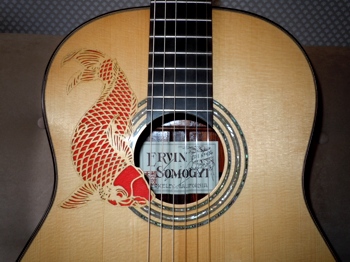FAQ #8: Flat Vs. Domed Tops
September 22, 2012
Q: In your book you recomend 30′ for a top radius, if one decides to buy a commercialy made disc. On the other hand I saw that James Goodall and Robert Taylor use 50′ and 65′ radiused dishes and Jim Olson & Kevin Ryan make FLAT non-radius tops. Olson said that he feels that these produce more responsive tops. So why, exactly, do you recomend a 30′ one? Wouldn’t a 65′ one be better since it is closer to being FLAT?
A: It’s a question of balancing various factors — very similar to a cook’s gauging how much of this and/or that spice or flavoring to use in making a dinner.
In the guitar (instead of carrots, lamb, and oregano) the ingredients are the string tension, the torque from the bridge, the mass of the braced top (which is arrived at by any combination of top thickness and bracing mass), top bracing and reinforcement (that is, the pattern and layout of the braces, as well as their profiling and height), and desired target sound (the resultant mix of monopole and dipoles, as well as sustain and dynamics).
There is no “correct” way to make a guitar. If there were, they’d all sound the same — just as if there were only one recipe for making French onion soup: then all French onion soup would taste exactly the same. In the biological realm, it would be equivalent to having every wife, husband, boyfriend, girlfrend, son, daughter, etc. be clones. So let’s forget “the one best way” of doing something complex.
Jim Olsen holds that a flat top is the most responsive. Very well. But what, exactly, does that mean? Does this not have something to do with how thick and/or stiff the top is, or how it is braced? And how it responds to the mechanical pull of the strings? I suspect that it does. So if we were to imagine a VERY thin top that is made flat, it would be easy to imagine it buckling or caving in under the pull of the strings… unless the bracing were beefy enough to make up for the weakness of such a flat plate. In other words, you could make that flimsy face hold up by adding more reinforcing.
You could also/instead make that flimsy face hold up better by putting an arch or dome into it. Arched structures are stiffer and more stable than flat ones — just as a pointed or arched roof on a house will hold up to rain and snow better than a flat one. Western architecture took a mighty step forward when structural doming became possible: the materials themselves — rather than supports, trusses, beams, and buttresses — achieve the required structural integrity, Analogously, if you put a dome or arch into the guitar face, you could use less bracing and achieve the same stiffness with fewer materials (i.e. less mass).
Less mass is good; it means that the strings have to strain less to coax sound out of the top. The strings need to work harder to get sound out of a heavy top — exactly as a horse has to pull harder to make a heavily loaded wagon move. You can appreciate that different archings/domings induce different amounts of stiffness into a plate. As can different thicknesses of that plate. And so can different sizes and layouts of braces. These are, in fact, the three main ingredients of top-making, exactly as flour, water, and eggs are three main ingredients in bread making. And in both guitars and bread the ingredients can be mixed or combined in different ways to produce a successful product. In the guitar this goal is: a top that is intelligently constructed and reasonably lightweight (which goes to sound), and also able to hold up to the pull of the strings (which goes to long-term stability of the guitar).
In the guitar, ridiculously small (or small-seeming) amounts of these various ingredients can make a difference you can clearly hear. For instance, a bit more or less top thickness can offset a bit more or less doming. A bit more or less bracing can offset a bit more or less top thickness. And so on. Identifying and using only one of these factors as being “most important”, appealing though that idea is, turns out not to be realistic. If the guitar were a political construct rather than a mechanical one, then it would work best as a democracy in which every component is (not to make a pun) given its proper voice. To make one into a “leader” (in our sociopolitical sense of the word) is not what a guitar is all about.
